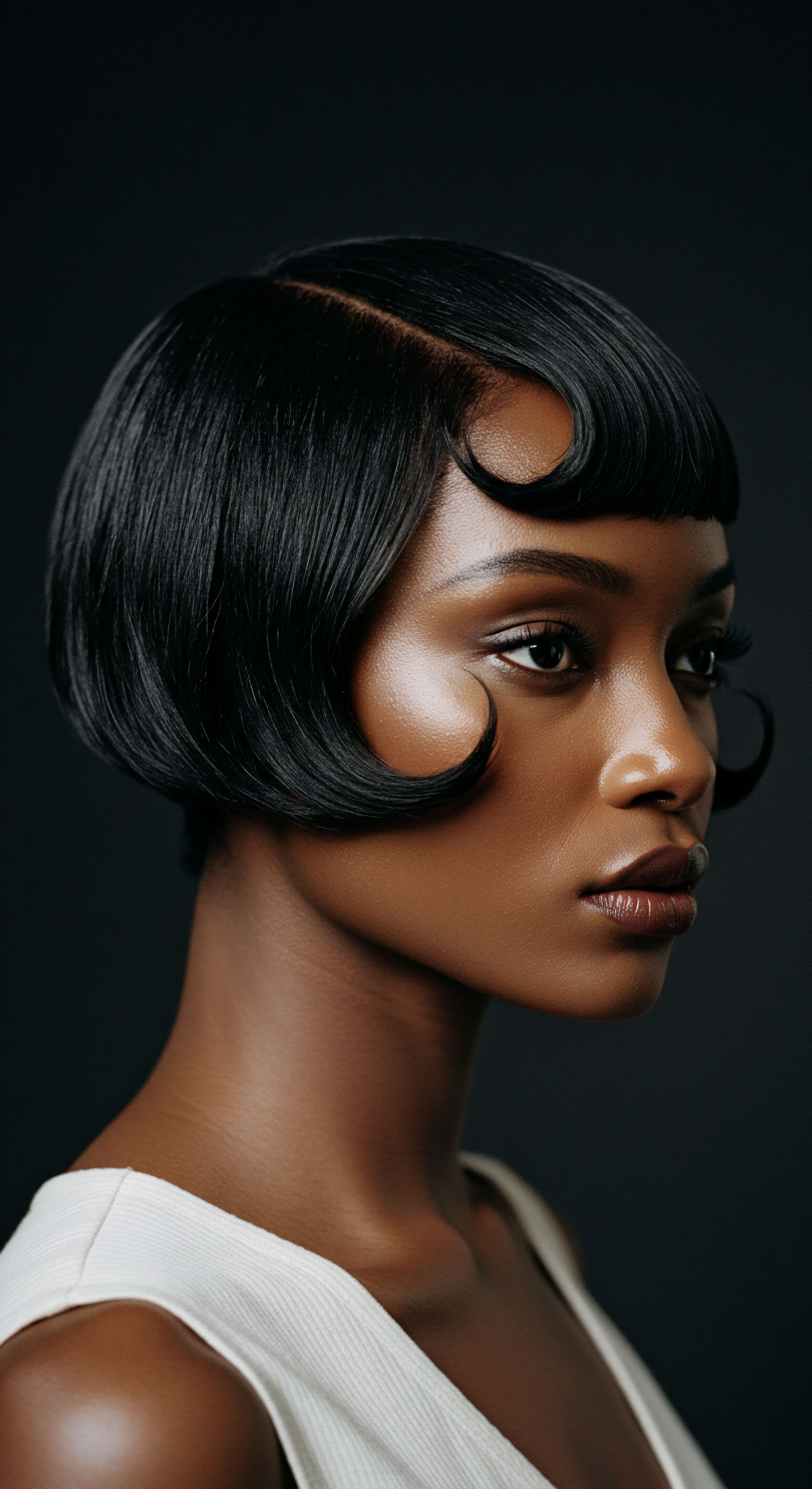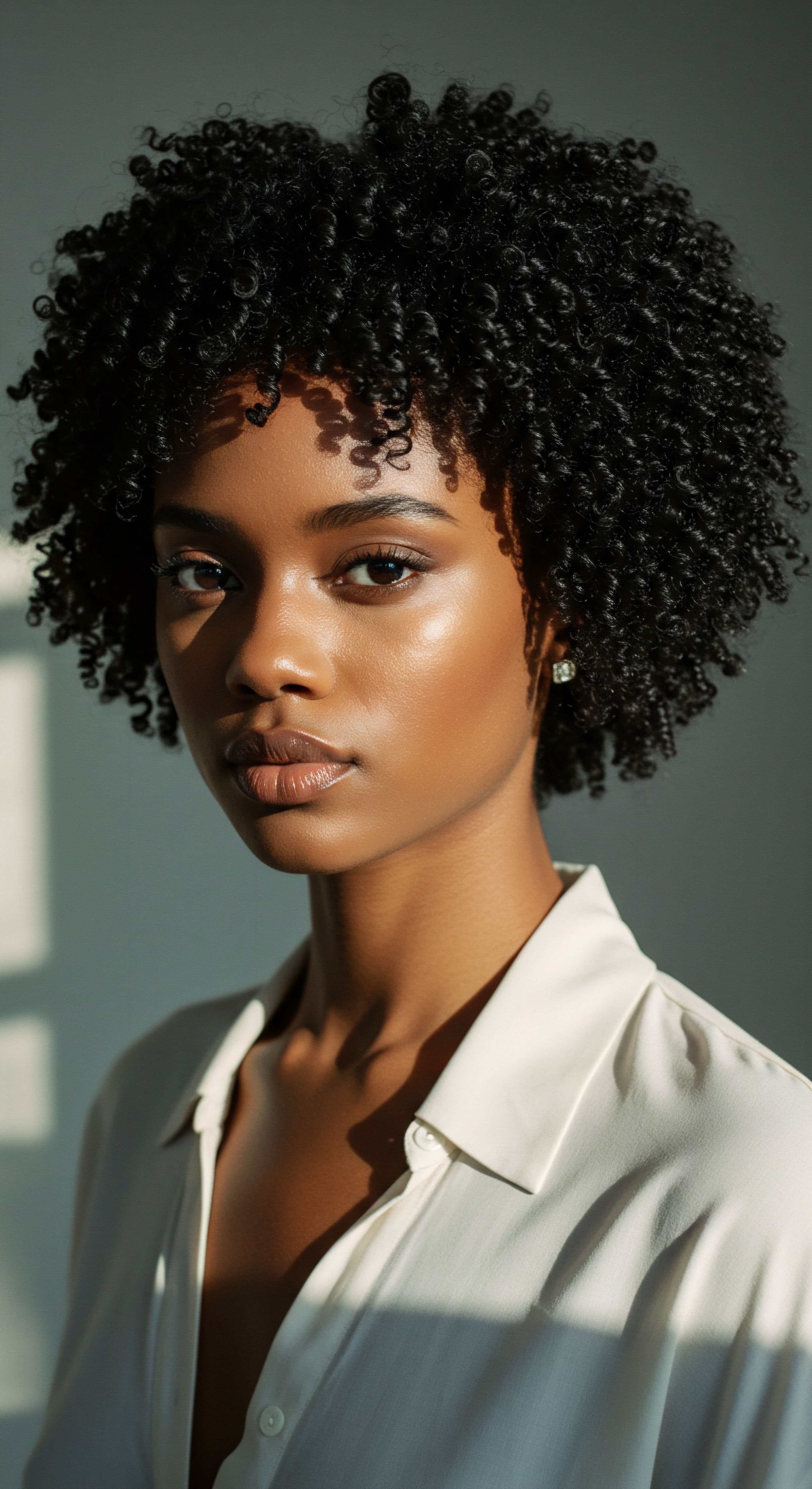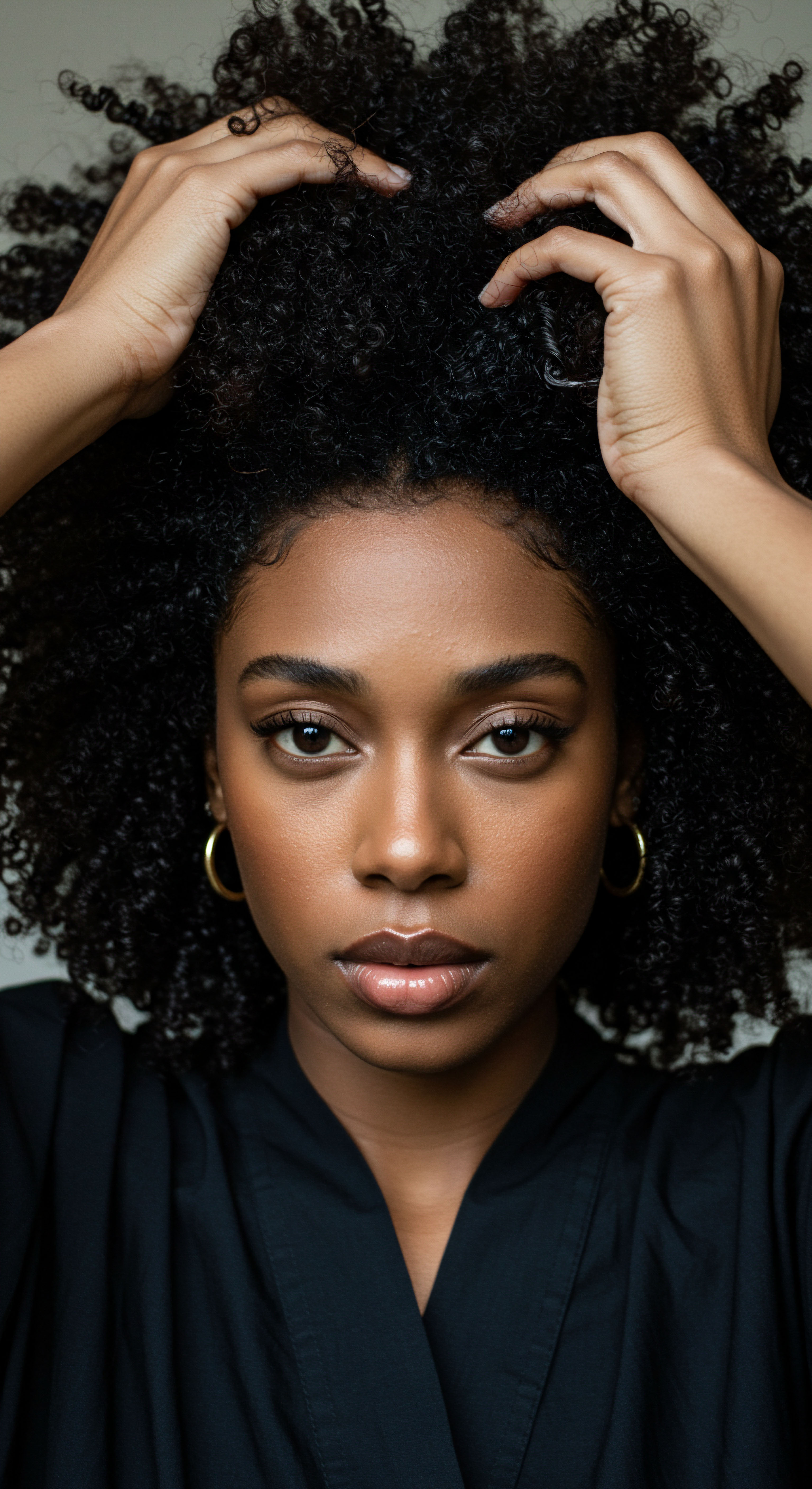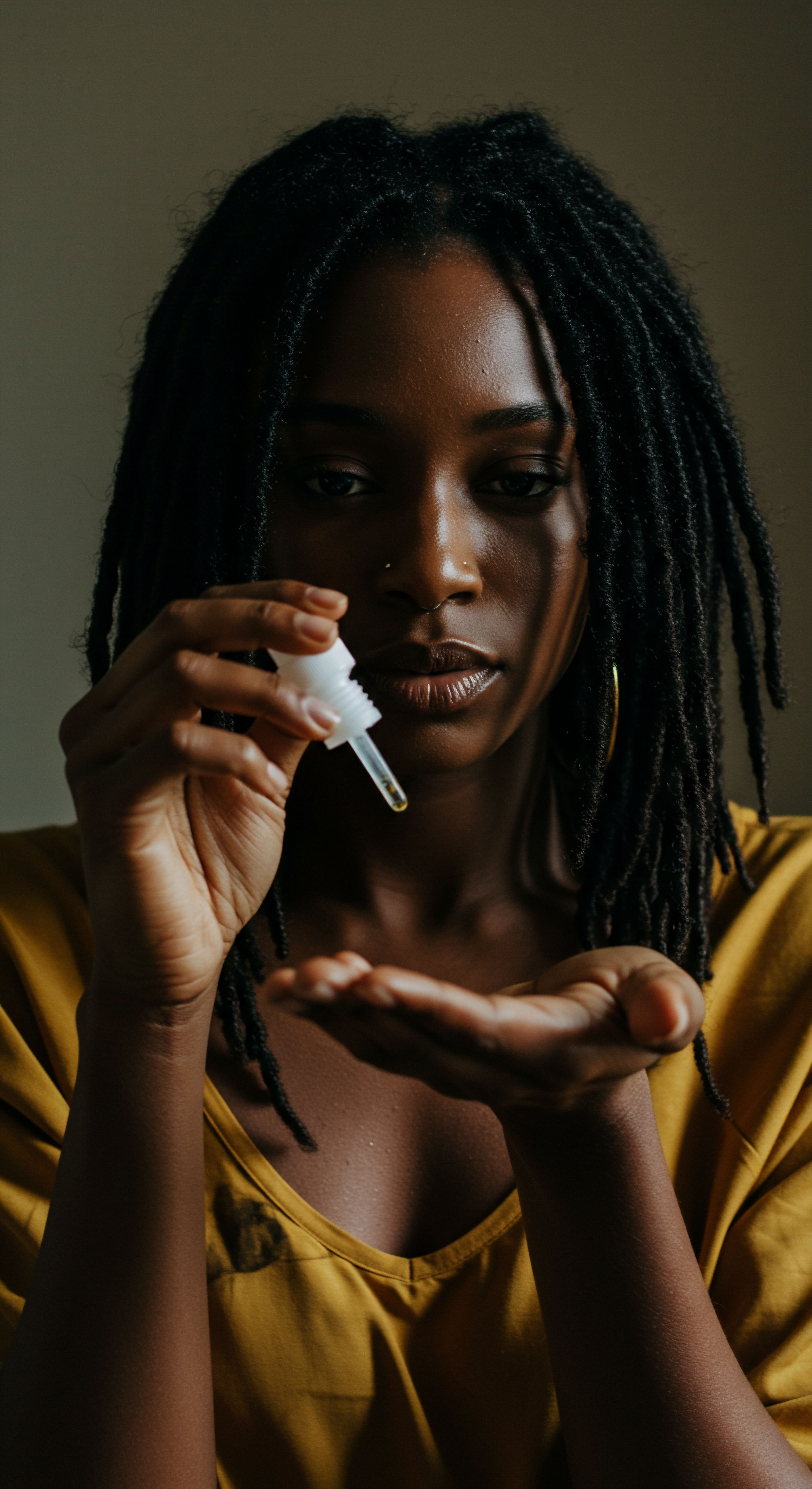
Roots
The quiet murmur of our hair, a daily whisper we often take for granted, holds within its very structure a story of ancient connections and delicate balances. It speaks of a relationship with the elements, particularly water, that is far more intricate than a simple wetting and drying. To truly comprehend how our strands interact with the moisture in the air, in our cleansing waters, and in our conditioning balms, we must first descend into the foundational architecture of each individual hair shaft.
This exploration begins at the outermost layer, the one we feel, the one that stands as the first line of engagement with the world ❉ the Cuticle. It is here, at this microscopic frontier, that the dance of absorption commences, a subtle negotiation shaping the very character of our hair’s hydration.

The Hair Shaft’s Outer Shield
Picture a single strand of hair, not as a smooth, uniform cylinder, but as a miniature pinecone or a shingled roof, composed of countless overlapping, flattened cells. These are the Cuticle Cells, arranged in a protective, scaly pattern. Each cell points towards the hair’s tip, creating a surface that, when healthy and aligned, presents a relatively smooth, water-repellent exterior.
This arrangement is not arbitrary; it is a marvel of biological engineering, designed to shield the delicate inner cortex from external aggressors while carefully mediating what enters and exits the strand. The integrity of this outer layer dictates much about how hair behaves, particularly its capacity to welcome or resist water.
The chemical composition of these cells, primarily keratin proteins, plays a significant role in their interaction with water. The outer surface of the cuticle is coated with a thin, lipid-rich layer, primarily composed of 18-methyl eicosanoic acid (18-MEA), a fatty acid that is covalently bonded to the keratin. This lipid layer is inherently Hydrophobic, meaning it repels water, serving as a natural barrier.
When this protective layer is intact, water struggles to penetrate, leading to lower absorption rates and often, a smoother, more reflective appearance. Conversely, when this layer is compromised through chemical treatments, heat styling, or mechanical friction, the underlying keratin, which is more hydrophilic, becomes exposed, inviting water to enter more readily.
The hair cuticle, an outer shield of overlapping cells, orchestrates a strand’s moisture interaction, dictating its hydration journey.

How Cuticle Arrangement Influences Water Entry
The precise arrangement of cuticle cells is not uniform across all hair types, and this variation holds significant sway over how hair absorbs moisture. For textured hair, the cuticle scales tend to be more lifted, less tightly compressed, and often more numerous per unit length of hair compared to straight hair. This characteristic open structure, often described as having a higher Porosity, creates more potential entry points for water molecules. Consider the microscopic gaps and raised edges of these scales; each tiny opening acts as a potential gateway for water to seep beneath the protective exterior and into the hair’s inner core, the cortex.
When the cuticle is raised, whether naturally or due to damage, the hair becomes more absorbent. This heightened absorbency can be a double-edged sword. On one side, it allows conditioning agents and hydrators to penetrate more readily, leading to better moisture retention when the hair is properly cared for.
On the other side, it means the hair can lose moisture just as quickly to the surrounding environment, leading to dryness and susceptibility to humidity-induced frizz. The ability of the cuticle to swell and lift in the presence of water, and then to lay flat again as it dries, is a dynamic process central to its role in moisture regulation.

The Role of Intercellular Lipids
Beyond the outermost surface, the spaces between the cuticle cells themselves are not empty. These intercellular regions contain a complex mixture of lipids, proteins, and other substances that contribute to the overall barrier function of the cuticle. These Intercellular Lipids act as a kind of mortar, binding the cuticle cells together and further restricting uncontrolled water movement.
Damage to these lipid pathways, often a result of strong detergents or harsh chemical processes, can disrupt the cuticle’s cohesive structure, creating additional avenues for moisture to enter and, critically, to escape. A healthy, well-sealed cuticle, therefore, depends not only on the alignment of its scales but also on the integrity of the material holding those scales in place.
Understanding the hair’s intrinsic architecture, particularly the disposition of its cuticle, lays the groundwork for truly informed hair care. It moves beyond superficial observations to a recognition of the profound biological mechanisms at play, inviting a deeper appreciation for the unique qualities of each strand.

Ritual
Our daily gestures, the gentle washing, the tender conditioning, the careful styling — these are not mere routines but expressions of a quiet understanding, a rhythmic engagement with our hair’s intrinsic thirst. As we move from the foundational knowledge of the cuticle’s structure, our focus shifts to the tangible interactions, the intentional practices that directly influence how our hair drinks in and holds onto precious water. This section seeks to illuminate the practical wisdom woven into our hair care rituals, guiding us toward practices that honor the cuticle’s role in moisture balance. It is here that science meets daily habit, where the microscopic realities of the hair shaft translate into tangible softness and lasting hydration.

Cleansing and the Cuticle’s Response
The act of cleansing, while essential for scalp health and removing build-up, represents a significant interaction with the hair cuticle. Shampoos, particularly those with strong anionic surfactants, can cause the cuticle scales to lift. This lifting is a necessary part of the cleansing process, allowing dirt, oil, and product residue to be effectively rinsed away.
However, prolonged exposure to harsh cleansing agents or excessively hot water can leave the cuticle in a persistently raised state, making the hair feel rough and more susceptible to moisture loss. The goal, then, becomes a delicate balance ❉ achieving cleanliness without unduly disrupting the cuticle’s natural alignment.
The choice of cleansing agent directly impacts the cuticle’s disposition. Sulfate-Free Cleansers, for instance, are often formulated with milder surfactants that cause less swelling and lifting of the cuticle scales compared to their sulfate-containing counterparts. This gentler action helps to preserve the hair’s natural moisture barrier, making them a preferred choice for textured hair types that are inherently prone to dryness. The temperature of the water also plays a part; while warm water helps to open the cuticle for cleansing, a final rinse with cooler water can help to encourage the scales to lie flatter, sealing in moisture and enhancing shine.
Hair care rituals, from cleansing to conditioning, are direct engagements with the cuticle’s moisture-regulating function.

Conditioning and Sealing the Surface
Conditioners serve as the primary allies in managing the cuticle’s interaction with moisture. These formulations are designed to deposit positively charged ingredients, such as cationic surfactants and polymers, onto the negatively charged surface of the hair cuticle. This attraction helps to smooth down the lifted scales, thereby reducing friction, enhancing shine, and, critically, creating a more cohesive barrier against moisture loss. The act of conditioning is akin to gently pressing down the shingles of a roof after a storm, restoring its protective integrity.
Leave-in conditioners and stylers further reinforce this protective layer. They often contain humectants, emollients, and occlusives. Humectants, like glycerin or hyaluronic acid, draw moisture from the air into the hair, provided the ambient humidity is higher than that within the hair. Emollients, such as natural oils and butters, soften the hair and fill in gaps between cuticle scales, contributing to smoothness.
Occlusives, like silicones or certain waxes, form a thin film on the hair surface, physically sealing the cuticle and slowing down the rate of water evaporation from the hair shaft. The strategic layering of these products helps to create a sustained environment of hydration for the hair.

The Practice of Deep Conditioning
Deep conditioning treatments represent a more intensive approach to cuticle care and moisture absorption. These treatments typically contain higher concentrations of conditioning agents, proteins, and humectants, often with a slightly lower pH to help close the cuticle. Applying gentle heat during a deep conditioning session can temporarily lift the cuticle just enough to allow the beneficial ingredients to penetrate more effectively into the cortex, providing internal hydration and strength.
Upon cooling, the cuticle aims to return to its flattened state, effectively trapping these conditioning agents within the hair. This process significantly improves the hair’s elasticity, softness, and overall ability to retain moisture over time.
Consider the consistent practice of moisturizing and sealing, particularly for hair with a naturally open cuticle structure. The application of water-based products followed by an oil or butter helps to create a layered defense. The water provides the initial hydration, which is then sealed in by the lipid layer, preventing its rapid escape. This methodical approach supports the cuticle in its vital role, transforming potential moisture vulnerability into enduring suppleness.

Relay
Beyond the immediate science and daily rituals, our hair’s relationship with moisture unfurls into a grander dialogue, a relay of influences stretching from our ancestral practices to the very air we breathe. To truly grasp how the cuticle shapes moisture absorption, we must ascend to a more sophisticated vantage point, where biological intricacies intertwine with cultural heritage and environmental conditions. This section invites us to consider the deeper currents at play, acknowledging that the hair strand is not an isolated entity but a responsive participant in a complex system, constantly adapting its moisture balance to its surroundings and its care. Here, we seek a profound appreciation for the layered story of hair hydration, recognizing its scientific underpinnings within a rich cultural and environmental context.

The Genetic Blueprint of Cuticle Configuration
The distinctive patterns of textured hair, from the tightest coils to the loosest waves, are a consequence of the hair follicle’s unique shape and the subsequent growth pattern of the hair shaft. This genetic predisposition also influences the cuticle’s configuration. Studies have shown that hair with a higher degree of curl tends to have cuticle scales that are more lifted at the edges and less uniformly overlapped compared to straight hair.
This inherent structural difference contributes significantly to the natural porosity observed in many textured hair types. The more open the cuticle, the more readily water can enter and leave the hair shaft, a characteristic that necessitates particular care strategies to maintain hydration.
A study published in the Journal of Cosmetic Science, examining the morphological characteristics of various hair types, highlighted that the number of cuticle layers and their arrangement vary significantly across different ethnic groups. For instance, African hair often presents with fewer cuticle layers (typically 5-6) compared to Caucasian (8-10) or Asian hair (10-12), and these layers tend to be thinner and more prone to lifting. This inherent structural difference means that African Hair may have a greater propensity for moisture loss due to a less robust outer barrier.
The research indicates that the Average Water Content of African hair can be lower than other hair types, making it more susceptible to dryness and breakage if not adequately moisturized. This biological reality underscores the wisdom in traditional and modern practices that prioritize sealing and protecting textured hair.
Hair’s genetic make-up dictates cuticle configuration, impacting natural porosity and demanding specific moisture care.

Environmental Factors and Cuticle Integrity
The environment in which we live exerts a constant, often subtle, influence on the hair cuticle and its ability to manage moisture. Humidity, for example, directly affects how water molecules interact with the hair. In highly humid environments, water vapor from the air can readily penetrate a porous cuticle, leading to swelling of the hair shaft and the familiar phenomenon of frizz as the hair attempts to absorb moisture from its surroundings.
Conversely, in arid climates, hair can quickly lose its internal moisture to the dry air, leading to dehydration and brittleness. Understanding these environmental pressures is paramount to adapting hair care routines to support the cuticle’s function.
Other environmental stressors, such as UV radiation from the sun and pollutants in the air, can also compromise cuticle integrity. UV exposure can degrade the lipid layer and damage the keratin proteins within the cuticle, making it more porous and less effective as a barrier. Similarly, particulate matter and chemical pollutants can deposit on the hair surface, disrupting the cuticle’s smoothness and potentially interfering with its ability to lay flat. These external aggressors necessitate protective measures, such as hats, scarves, and products containing UV filters or antioxidants, to shield the cuticle from harm and preserve its vital role in moisture regulation.

The PH Balance and Cuticle Sealing
The concept of pH, a measure of acidity or alkalinity, holds significant sway over the cuticle’s behavior. Hair and scalp typically have a slightly acidic pH, generally ranging from 4.5 to 5.5. This acidic environment helps to keep the cuticle scales tightly closed and flat, contributing to a smooth, shiny appearance and effective moisture retention.
When hair is exposed to alkaline substances, such as harsh shampoos, relaxers, or certain coloring agents, the cuticle scales swell and lift. This opening is often desired for chemical processes to allow penetration, but if the hair is not subsequently brought back to an acidic pH, the cuticle can remain open, leading to increased porosity and vulnerability to damage and moisture loss.
The use of acidic rinses, like diluted apple cider vinegar, or conditioners formulated with a lower pH, serves to restore the hair’s natural acidity. This action helps to contract the cuticle scales, encouraging them to lie flat against the hair shaft. The resulting smooth surface not only reflects light more effectively, giving the hair a healthy sheen, but also significantly reduces the rate at which water can escape from the hair’s inner core. This precise management of pH is a subtle yet potent tool in optimizing the cuticle’s barrier function and sustaining hair hydration.
| Hair Type Descriptor African Hair (Coily/Kinky) |
| Typical Cuticle Layers 5-6 |
| Cuticle Scale Arrangement More lifted, less uniformly overlapped |
| Moisture Absorption Tendency Higher (due to more open structure) |
| Hair Type Descriptor Caucasian Hair (Straight/Wavy) |
| Typical Cuticle Layers 8-10 |
| Cuticle Scale Arrangement More uniform, tightly overlapped |
| Moisture Absorption Tendency Moderate |
| Hair Type Descriptor Asian Hair (Straight) |
| Typical Cuticle Layers 10-12 |
| Cuticle Scale Arrangement Very uniform, densely packed |
| Moisture Absorption Tendency Lower (due to very compact structure) |
| Hair Type Descriptor Differences in cuticle structure profoundly influence how hair interacts with water, shaping its hydration needs. |

Chemical Treatments and Cuticle Compromise
Chemical treatments, such as coloring, bleaching, and chemical straightening or relaxing, exert a profound impact on the hair cuticle. These processes are designed to intentionally disrupt the cuticle layer to access the cortex. Bleaching, for example, oxidizes the melanin pigments within the cortex and also damages the protective lipid layer and protein structure of the cuticle, leaving it highly porous and often permanently raised. Similarly, chemical relaxers break down disulfide bonds within the cortex but also cause significant swelling and lifting of the cuticle scales, making the hair more vulnerable to environmental damage and moisture loss.
The consequences of these treatments on moisture absorption are significant. Hair with a compromised cuticle becomes highly absorbent, capable of taking in large amounts of water very quickly. However, this increased absorbency comes at the cost of retention. The damaged cuticle cannot effectively seal in the moisture, leading to rapid dehydration.
This is why chemically treated hair often feels dry, brittle, and is prone to breakage. Restorative treatments that aim to replenish lost lipids and proteins, and to temporarily smooth the cuticle, become absolutely essential for maintaining the health and hydration of such hair.
- Cuticle Lifting ❉ The opening of the outermost protective layer of hair, often caused by alkaline products or damage, allowing water to enter.
- Hydrophobic Layer ❉ The water-repellent lipid coating on the hair’s surface, critical for resisting excessive moisture absorption.
- Hair Porosity ❉ The hair’s capacity to absorb and retain moisture, directly influenced by the state of its cuticle.

The Silent Language of Hair Porosity
Hair porosity, a term frequently heard in discussions of hair care, is fundamentally a descriptor of the cuticle’s state and its willingness to interact with water. Low porosity hair typically possesses a tightly closed cuticle, making it difficult for water to penetrate but also for it to escape once inside. This hair type can be resistant to hydration initially but retains moisture well. High porosity hair, on the other hand, has a more open or damaged cuticle, allowing water to enter and leave with ease.
While this means quick absorption, it also signifies equally quick evaporation, leading to chronic dryness unless properly sealed. Medium porosity hair strikes a balance, absorbing and retaining moisture effectively without extreme tendencies.
Recognizing one’s hair porosity is not merely an academic exercise; it is a practical compass for navigating product choices and care routines. For instance, low porosity hair benefits from lighter, more penetrating products and perhaps gentle heat to aid absorption, while high porosity hair requires heavier, occlusive products to seal the cuticle and prevent rapid moisture loss. The cuticle, in its varied states of openness, speaks a silent language about the hair’s hydration needs, guiding us toward thoughtful and effective care.

Reflection
As we journey through the intricate world of the hair cuticle and its profound influence on moisture absorption, a singular truth begins to crystallize ❉ our hair is a living testament to responsiveness. Each strand, with its unique cuticle architecture, stands as a delicate sensor, constantly engaging with the internal rhythms of our bodies and the external dance of our environments. From the genetic whisper that shapes its initial configuration to the conscious choices we make in its care, the cuticle orchestrates a silent, ceaseless negotiation with water.
To truly care for our hair, particularly textured hair, is to listen to this quiet dialogue, to honor its inherent structure, and to adapt our practices with thoughtful intention. It is a beautiful call to understand, to nurture, and to celebrate the remarkable resilience of our crowns, allowing them to drink deeply and radiate their authentic splendor.

References
- Franbourg, A. Hallegot, P. Baltenneck, F. Freyssinet, J. M. & Bouillon, C. (2003). Current research on ethnic hair. Journal of Cosmetic Science, 54(5), 515-533.
- Robbins, C. R. (2012). Chemical and Physical Behavior of Human Hair (5th ed.). Springer.
- Gavazzoni, M. F. (2018). Hair Care ❉ An Illustrated Dermatologic Handbook. Springer.
- Feughelman, M. (1995). Mechanical Properties of Hair. Springer.
- Khosa, S. K. & Sharma, A. (2019). Hair ❉ Anatomy, Physiology and Cosmetic Care. International Journal of Pharmaceutical Sciences and Research, 10(6), 2582-2591.
- Hotting, S. (2014). The Hair Fibre ❉ A Comprehensive Overview. Cosmetics & Toiletries, 129(1), 38-46.
- Draelos, Z. D. (2010). Hair Cosmetics ❉ An Overview. CRC Press.
- Wolfram, L. J. (2003). Hair. Ullmann’s Encyclopedia of Industrial Chemistry. Wiley-VCH.
- Dias, M. F. R. G. (2015). Hair Cosmetics ❉ An Overview. International Journal of Trichology, 7(1), 2-15.
- Buffoli, B. Rinaldi, F. Labanca, M. Sorbellini, E. Trink, A. Guanziroli, E. Rezzani, R. & Rodella, L. F. (2014). The human hair ❉ from anatomy to physiology. International Journal of Dermatology, 53(3), 331-341.